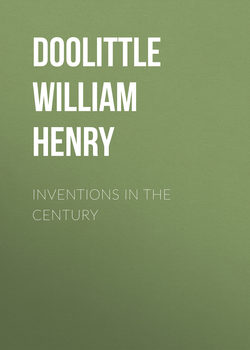Inventions in the Century

Реклама. ООО «ЛитРес», ИНН: 7719571260.
Оглавление
Doolittle William Henry. Inventions in the Century
CHAPTER I. INTRODUCTORY – INVENTIONS AND DISCOVERIES – THEIR DEVELOPMENT
CHAPTER II. AGRICULTURE AND ITS IMPLEMENTS
CHAPTER III. AGRICULTURAL IMPLEMENTS
CHAPTER IV. AGRICULTURAL INVENTIONS
CHAPTER V. AGRICULTURAL INVENTIONS (continued)
CHAPTER VI. CHEMISTRY, MEDICINES, SURGERY, DENTISTRY
CHAPTER VII. STEAM AND STEAM ENGINES
CHAPTER VIII. ENGINEERING AND TRANSPORTATION
CHAPTER IX. ELECTRICITY
CHAPTER X. HOISTING, CONVEYING AND STORING
CHAPTER XI. HYDRAULICS
CHAPTER XII. PNEUMATICS AND PNEUMATIC MACHINES
CHAPTER XIII. ART OF HEATING, VENTILATING, COOKING, REFRIGERATION AND LIGHTING
CHAPTER XIV. METALLURGY
CHAPTER XV. METAL WORKING
CHAPTER XVI. ORDNANCE, ARMS AND EXPLOSIVES
CHAPTER XVII. PAPER AND PRINTING
CHAPTER XVIII. TEXTILES
CHAPTER XIX. GARMENTS
CHAPTER XX. INDUSTRIAL MACHINES
CHAPTER XXI. WOOD-WORKING
CHAPTER XXII. FURNITURE
CHAPTER XXIII. LEATHER
CHAPTER XXIV. MINERALS – WELLS
CHAPTER XXV. HOROLOGY AND INSTRUMENTS OF PRECISION
CHAPTER XXVI. MUSIC, ACOUSTICS, OPTICS, FINE ARTS
CHAPTER XXVII. SAFES AND LOCKS
CHAPTER XXVIII. CARRYING MACHINES
CHAPTER XXIX. SHIPS AND SHIP-BUILDING
CHAPTER XXX. ILLUMINATING GAS
CHAPTER XXXI. BRICK, POTTERY, GLASS, PLASTICS
Отрывок из книги
The Egyptians were the earliest and greatest agriculturists, and from them the art was learned by the Greeks. Greece in the days of her glory greatly improved the art, and some of her ablest men wrote valuable treatises on its different topics. Its farmers thoroughly ploughed and fertilised the soil, used various implements for its cultivation, paid great attention to the raising of fruits, – the apple, pear, cherry, plum, quince, peach, lemon, fig and many other varieties suitable to their climate, and improved the breeds of cattle, horse and sheep. When, however, social pride and luxurious city life became the dominant passions, agriculture was left to menials, and the art gradually faded with the State. Rome in her best days placed farming in high regard. Her best writers wrote voluminously on agricultural subjects, a tract of land was allotted to every citizen, which was carefully cultivated, and these citizen farmers were her worthiest and most honoured sons. The condition and needs of the soil were studied, its strength replenished by careful fertilisation, and it was worked with care. There were ploughs which were made heavy or light as the different soils required, and there were a variety of farm implements, such as spades, hoes, harrows and rakes. Grains, such as wheat, barley, rye and oats, were raised, a variety of fruits and vegetables, and great attention paid to the breeding of stock. Cato and Varro, Virgil and Columella, Pliny and Palladius delighted to instruct the farmer and praise his occupation.
But as the Roman Empire grew, its armies absorbed its intelligent farmers, the tilling of the soil was left to the menial and the slave, and the Empire and agriculture declined together.
.....
The threshing-floor still resounds to the flail as the grain is beaten from the heads of the stalks. Men and horses still tread it out, the wooden drag and the heavy wain with its gang of wheels, and all the old methods of threshing familiar to the Egyptians and later among the Romans may still be found in use in different portions of the world.
Menzies of Scotland, about the middle of the eighteenth century, was the first to invent a threshing machine. It was unsuccessful. Then came Leckie, of Stirlingshire, who improved it. But the type of the modern threshing machine was the invention of a Scotchman, one Meikle, of Tyningham, East Lothian, in 1786. Meikle threw the grain on to an inclined board, from whence it was fed between two fluted rollers to a cylinder armed with blades which beat it, thence to a second beating cylinder operating over a concave grating through which the loosened grain fell to a receptacle beneath; thence the straw was carried over a third beating cylinder which loosened the straw and shook out the remaining grain to the same receptacle, and the beaten straw was then carried out of the machine. Meikle added many improvements, among which was a fan-mill by which the grain was separated and cleaned from both straw and chaff. This machine, completed and perfected about the year 1800, has seen no departure in principle in England, and in the United States the principal change has been the substitution of a spiked drum running at a higher speed for Meikle's beater drum armed with blades.
.....